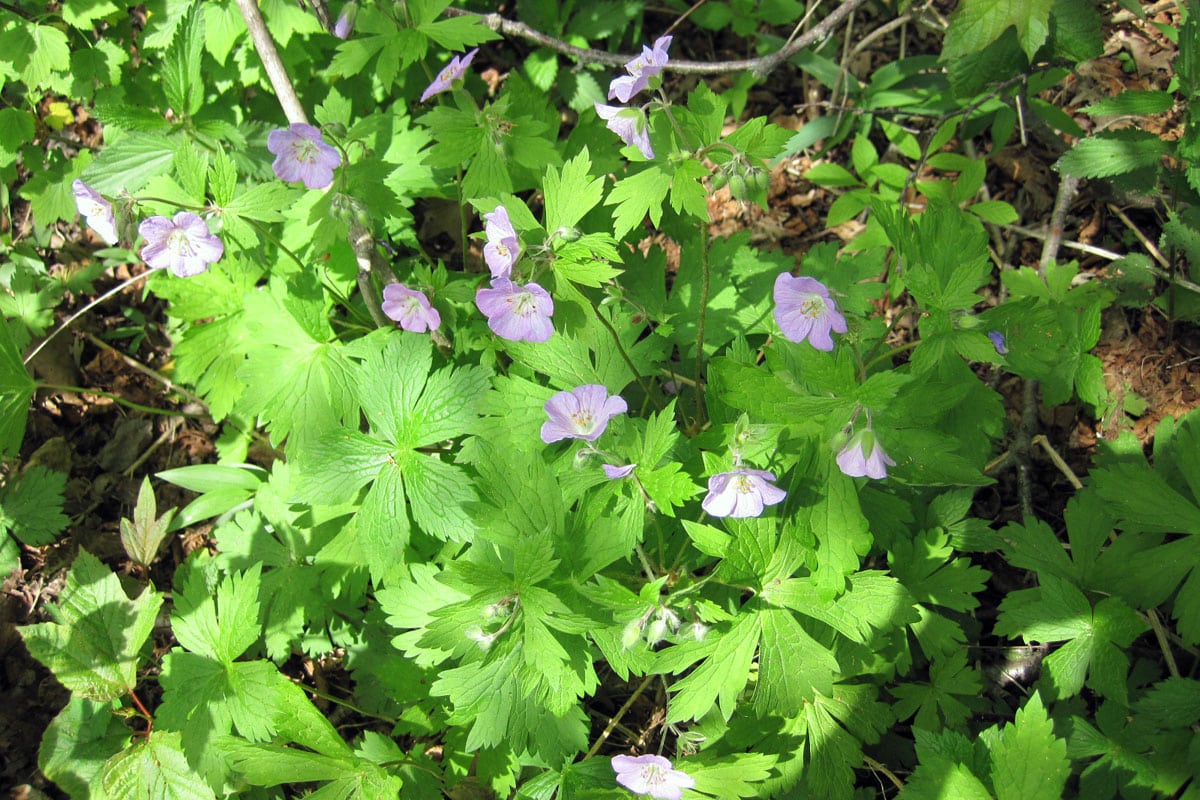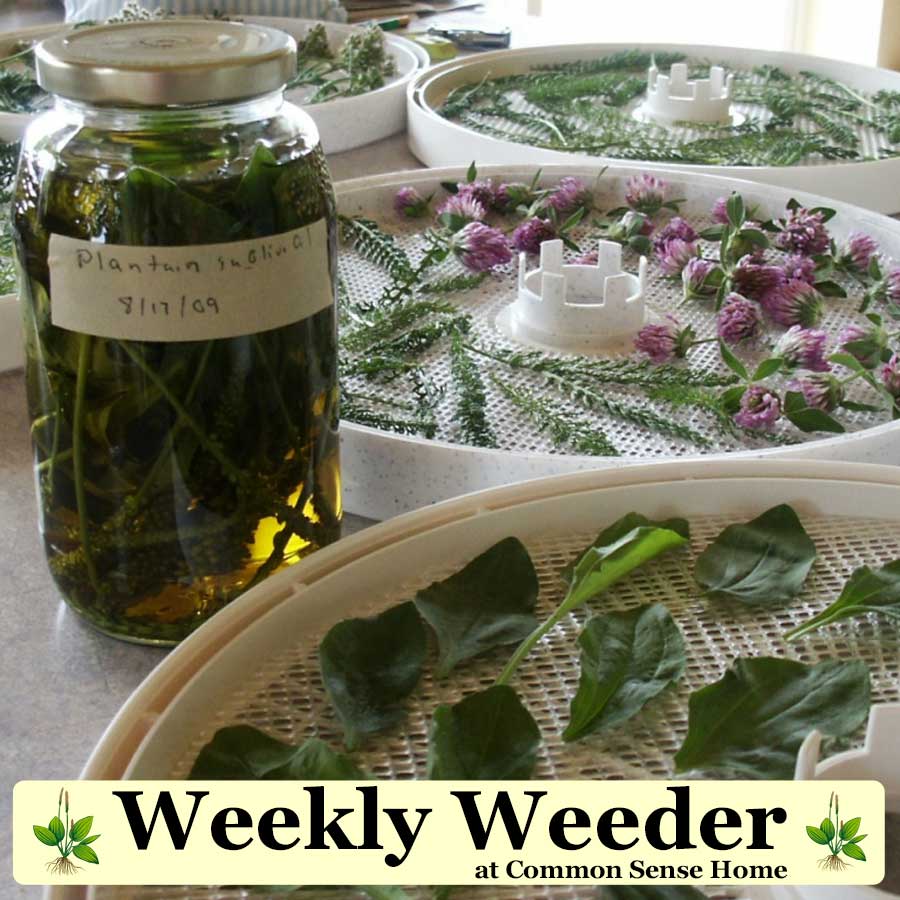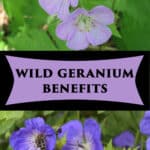Wild Geranium (Geranium maculatum) Identification & Use
This post may contain affiliate links. Read my full disclosure here.
Wild Geranium, Geranium maculatum, is a lovely Eastern North American native plant. It works well in woodland gardens or as groundcover, nurturing pollinators and other wildlife. It also has a long history of medicinal use. We’ll share how to identify, grow, and use this woodland beauty.

Range and Identification of Wild Geranium
Wild geranium is native to eastern North America, growing from zones 3 to 8. Its range reaches all the way from Manitoba and Quebec to Alabama and west to Oklahoma and South Dakota. While typically found in dry, shady, deciduous woodlands and meadows, it also grows in full sun.
The plant is a perennial in the geranium family (Geraniaceae), growing to 1 to 2 feet tall. The deeply lobed palmate leaves form clumps of vegetation, covering forest floors. The stem leaves attach in pairs, and are up to 5 inches long. Coarse hairs cover the undersides of leaves, giving them a fuzzy appearance.
The wild geranium blooms from spring into summer, with bloom time varying by location. Depending on your area, blooms emerge between March and July. Blooms last around a month, but may last longer in cooler weather.

Flowers are 1-2″ across and 2-3 stem leaves (flower growing leaves) per plant. Each plant has 2 to 10 flowers, with five petals per flower. The pink or lavender blossoms have lines running the length of the petals, and 10 bright yellow stamens surround the single center pistil.
Before opening, the seed capsule resembles the bill of a crane, thus the name “Crane’s bill geranium”. The seed capsules split into 5 long and curled “peals” to release seeds, firing them 10 to 30 feet away from the parent plant.
Cultivation
You can propagate Geranium maculatum from seeds, potted plants, or bare-root plants. The plants die back to their rhizomes each year. Transplanting mature plants after the plant goes dormant for the year will minimize transplant shock.
Plant in full sun to partial shade, preferably in sandy loam. When planting in full sun, make sure the soil is rich and stays consistently damp. (Ramial wood mulch is a good option.) Space plants about 1 foot apart.
Plant young plants in early spring to give them plenty of time to get established. The seeds require stratification to germinate, so fall sowing works well. Young plants typically bloom their second or third year, and the leaves turn red and orange in fall.
Deadheading doesn’t produce more blossoms, but you can trim back plants if needed for a neater appearance. The plants will spread over time, but are not aggressive growers. Mix them with summer and fall blooming natives to provide food for pollinators all season long.
Wildlife Uses
Many different pollinators, including solitary bees, bumblebees, and several species of butterflies feed on the nectar and pollen. Birds such as mourning doves and bobwhite quail eat the seeds. Though the foliage is somewhat deer resistant, white-tailed deer eat the flowers of wild geranium.
Medicinal Use of Wild Geranium
The book, “Edible & Medicinal Plant of the Midwest” sings the praises of wild geranium. It has a long history of herbal use for its astringent, styptic, and antimicrobial properties.
The United States Dispensatory of 1926 noted, “Geranium is one of our best indigenous astringents.” The major constituents of Geranium maculatum include tannin, gallic acid (after drying, from breakdown of the tannin), pectin, calcium oxide, gum, and resin.
Native American peoples used the plant for treatment of:
Would you like to save this?
- diarrhea
- hemorroids
- canker sores
- trench mouth
- infected teeth and gums
- bleeding wounds
- menorrhagia
- oral thrush
- mastitis
Other herbalists have employed it for:
- gastric ulcers
- duodenal ulcers
- herpes simplex infections
- influenza
- tonsilitis
- diverticulitis
- irritable bowel syndrome
- and more
The plant is commonly used internally as a strong decoction or tincture. To make the tincture, combine the dried plant at a 1:5 ratio with 50 percent alcohol and 10 percent glycerin. Dose at 1/2 to 1 teaspoon, as needed. See “Real Healing Potions” for more information on decoctions and tinctures.
For use as a styptic, the dried root is powdered or poulticed and applied to the wound. The root poultice is also used for teeth and gums. Geranium maculatum extracts are used in the cosmetic industry to promote dermal cell renewal.
Always exercise caution when using any wild plants, and make sure you have positively identified the plant. See your healthcare provider for serious disease or illness.
Contraindications
For short term internal use only, due to the high amount of tannins. Traditionally, some tribes used the plant as a contraceptive. Do not use it internally during pregnancy or when intending to conceive.
Other Common Names
Other common names for Wild Geranium include: Spotted Geranium, Wood Geranium, Alum Root, Alum Bloom, Old Maid’s Nightcap, Spotted Cranesbill, Wild Cranesbill and Crane’s-bill Geranium.
Note: This native plant is not closely related to commercial geraniums, Pelargonium hortorum. Both are in the Geranium family, but most commercial geraniums are native to southern Africa.

More Information about Wild Plants
Thanks so much for stopping by to visit. This post is #22 in the Weekly Weeder series, where share how to use common wild plants. You can view the entire series on the Herbs and Wildcrafting page.
Articles include:
- My Favorite Wildcrafting Resources
- Queen Anne’s Lace – Butterfly Host Plant and Blueberry Protector
- Grandma Called it Medicine Leaf

This article is written by Laurie Neverman. Laurie was raised on a small dairy farm in northwest Wisconsin, where she gathered wildflowers from the woods and pastures. She and her family now live in northeast Wisconsin, where they combine intentional plantings and semi-wild areas. Every season is a new opportunity to learn more about working with wild plants.
Originally posted in 2012, last updated in 2024.



Hi …. The link to Queen Anne’s Lace leads to the wildcrafting books list.
Always enjoy your articles. Thanks!
Fixed! Thank you for letting me know. For some reason the top link mapped onto the others in the list. Weird, but they should be working properly now.
Added one more weed to my salad!
Thanks!
You’re welcome. 🙂
When I go out into my yard and see this plant(most would consider a weed) It looks similar but different that some of the pictures I see online. Sometimes the lobes are more pronounced or there are no lobes at all just one leaf with a split in it. sometimes they look jagged and sometimes smooth. Is there just such a variety of geranium maculatum to explain these differences, or are they different plants altogether?
As I understand it, Geranium maculatum always features pronounced lobes, but their are other related species that are naturalized in the US.
“different species” doesn’t equal “not related”. Garden Geraniums and wild ones are in fact closely related, same family, same genus. Indeed, Wild Geranium is a garden plant, of which there are several cultivars. The cultivar ‘Elizabeth Ann’ won the Royal Horticultural Society Award of Merit.
I think we’re talking about different plants. I’m referring to Pelargonium hortorum, which is the type most commonly referred to as “geranium” in our local garden centers, not the other cranesbill types.
As noted on wikipedia:
I’ll clarify that when I update the post.
Laurie,
Thanks so much for all your info. I love the weekly weeder. Learning sooo much. I forage and use many different wild edibles in my green smoothies. I’ve found the more mature the leaves are the more bitter the flavor. I like to dry my young wild edible leaves in my dehydrator on 110 t0 115 degrees. Place in a jar and use all winter.
I think using a variety of greens in smoothies, if one is smoothie inclined, is a good idea to get a wider range of nutrients. Good tips. 🙂
Laurie ~
Thanks for mentioning my post 🙂 That’s a nice surprise.
I have a question about wild geranium and other plants: A lot of instructions on wild edibles say to eat the “young leaves”. Does that mean that the mature leaves are dangerous? Sorry if I sound stupid, but I’m still learning and don’t want to make myself/my kids sick!
Sincerely,
Jenny
Jenny – if mature leaves (or any part of the plant) are/is a cause for health concerns, it will normally be noted. It’s mainly a matter of palatability. Bigger leaves are tougher and chewier. Nice to “see” you. 🙂